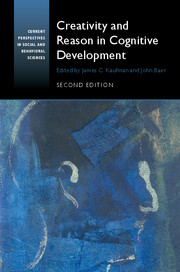Book contents
- Frontmatter
- Dedication
- Contents
- List of Contributors
- Acknowledgments
- 1 Creativity, Reason and Cognitive Development: Ten Years Later
- SECTION ONE CREATIVITY AND REASON IN CHILDHOOD AND THE SCHOOLS
- 2 Creativity in Young Children's Thought
- 3 Early Experiences and Creativity: An Ecological Perspective
- 4 Imaginative Play
- 5 Revisiting the Relationship among Schooling, Learning, and Creativity
- 6 Higher Level Thinking in Gifted Education
- 7 A Young Artist's Story: Advancing Knowledge and the Development of Artistic Talent and Creativity in Children
- SECTION TWO CREATIVITY AND REASON IN COGNITION AND NEUROSCIENCE
- SECTION THREE CREATIVITY AND REASON: INTERACTIONS AND RELATED CONSTRUCTS
- Author Index
- Subject Index
- References
7 - A Young Artist's Story: Advancing Knowledge and the Development of Artistic Talent and Creativity in Children
from SECTION ONE - CREATIVITY AND REASON IN CHILDHOOD AND THE SCHOOLS
Published online by Cambridge University Press: 05 February 2016
- Frontmatter
- Dedication
- Contents
- List of Contributors
- Acknowledgments
- 1 Creativity, Reason and Cognitive Development: Ten Years Later
- SECTION ONE CREATIVITY AND REASON IN CHILDHOOD AND THE SCHOOLS
- 2 Creativity in Young Children's Thought
- 3 Early Experiences and Creativity: An Ecological Perspective
- 4 Imaginative Play
- 5 Revisiting the Relationship among Schooling, Learning, and Creativity
- 6 Higher Level Thinking in Gifted Education
- 7 A Young Artist's Story: Advancing Knowledge and the Development of Artistic Talent and Creativity in Children
- SECTION TWO CREATIVITY AND REASON IN COGNITION AND NEUROSCIENCE
- SECTION THREE CREATIVITY AND REASON: INTERACTIONS AND RELATED CONSTRUCTS
- Author Index
- Subject Index
- References
Summary
Entering my paint-splattered studio, home to her daughter's art enrichment class, Jamie's (a pseudonym) mother eagerly approached my office space, a contagious smile lighting her face. She had good news to share regarding her recent meeting with Jamie's public school art teacher.
Jamie had been preparing for her first year in high school and both she and her mother were exploring options for her ongoing artistic training. Jamie's mother began the good-news conversation with obvious delight in the eighth-grade art teacher's favorable assessment of Jamie's artwork – paintings she had executed in my classroom. Impressed by Jamie's artistic ability, the teacher had recommended Jamie for the intensive art curriculum in the high school.
Thoroughly satisfied by the conversation I was having with her mother, Jamie looked over her shoulder at her current painting project resting on a paint-encrusted easel, and smiled.
“Did you tell her I have been taking art classes with Mrs. Rostan for seven years?”
she queried, with obvious pride in her achievements.
Her mother hesitated before responding, “No.”
Jamie's surprise and confusion were palpable as she looked at her mother, and then turned to me. I made every effort to hide my own bewilderment as I tried to grasp her mother's beliefs about Jamie's artistic ability and attempted to reassure Jamie that there must be a good reason for her mother's decision to withhold this information.
Her face strained from holding back her raw emotion, Jaimie asked her mother why she had not said anything. “Why didn't you tell my art teacher about all the years I have been taking art classes?”
Jamie's mother, suddenly forced to come to terms with conflicting beliefs, faltered and then attempted a clear and acceptable response: She believed that Jamie's eighth-grade art teacher had identified an innate talent in her daughter and she wanted to protect the potential resources signaled by this recognition. Mentioning her daughter's studies and “work” might undermine her own efforts to secure an “artistically talented” identification and special programs for her daughter. Her reasons were unsettling for both Jamie and me.
- Type
- Chapter
- Information
- Creativity and Reason in Cognitive Development , pp. 114 - 144Publisher: Cambridge University PressPrint publication year: 2016



